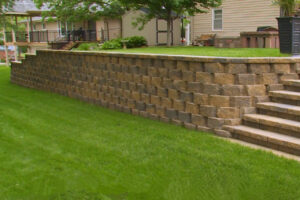Concrete Repair Colorado Springs can help reduce safety hazards and extend the lifespan of structures. In addition, repairing small problems can prevent them from expanding into more serious and costly issues.
Getting new concrete poured involves a lot of work and time commitment. However, it may be the best option, depending on what you’re looking to accomplish.

Concrete replacement is a significant undertaking that involves a lot of work. From finding a reputable contractor to demolishing and installing new concrete, it’s a project that can be very time-consuming, expensive, and messy. Then there are the risks that come with it – bad batches of concrete, torn-up lawns and landscaping, and more. Whether you’re a contractor or a property owner, many options are available for concrete repair and replacement.
One option that can save you a lot of hassle is routing and sealing. This method uses a specialized machine to enlarge the crack, leaving a V-shaped groove filled with a hot liquified rubber sealant. It is important to keep in mind that routing must be done prior to sealing to ensure that the liquified rubber can reach all areas of the crack, and not just what is on the surface. It is also essential that you prepare the surface to be sealed properly, as it must be free of dirt and debris.
Another option for repairing concrete surfaces is epoxy injection. This technique is best suited for dormant cracks that are not likely to progress further or that have not been caused by design or construction errors. It consists of applying a surface cap of non-sag epoxy to confine the crack, drilling holes at close intervals along horizontal, vertical or overhead cracks, and injecting epoxy under pressure. The injected epoxy bonds or welds the cracked concrete together, restores its as-designed strengths, and waterproofs the crack.
It’s also important to choose the right type of sealant for your project. There are many different types on the market, from epoxies to silicones and urethanes. Some are designed to be flexible, which is best for cracks that may grow or move over time, while others are harder and more suited for dormant or static cracks that will not expand or move.
Finally, you must take into consideration the coefficient of thermal expansion when selecting a concrete repair material. Most repair materials are sensitive to temperature fluctuations, so it’s crucial to select an appropriate product for the conditions.
Concrete is hard and durable, but it can become damaged over time. Holes and broken areas can be a nuisance, and they can allow water or rodents to enter your home. Filling in holes as soon as possible is a great way to prevent further damage and protect your property. Before you begin patching, remove any loose debris and wipe the area clean with a water-dampened rag. This will allow the patching material to bond tightly.
Next, if the hole is near your foundation walls, use a cold chisel to undercut the area and create a rough surface. This will help lock the new concrete into place and give it more strength than if you simply filled in the hole. You should also clean the undercut area thoroughly to eliminate any dirt or debris that can weaken the new concrete. If the hole is in a high traffic area, it may be a good idea to reinforce the concrete with mesh or rebar before filling in the repair.
Mix up the concrete patching material in a bucket and add less water than it specifies. The consistency should be pancake batter, rather than a paste. It should be easy to work with, but still firm enough to stay in place once it dries. Pour the concrete into the hole, packing it firmly and spreading it evenly. After you have leveled the concrete, wet a trowel and gently smooth out the surface to blend it with the existing concrete.
If you are using a pre-mixed concrete patch, follow the package instructions for application. Otherwise, mix the concrete according to the manufacturer’s guidelines. It’s important that the concrete be mixed well and not too thick to get a strong, long-lasting repair.
Once the concrete is dry, spray it with a water hose to make sure there are no puddles left in the patch. Water that remains will suck up the cement, weakening it. If you are doing a large area, consider using a commercial concrete cleaner to help you remove any tough stains or buildup.
If a concrete floor has delamination, repairing it involves much more than slapping patching mortar over the area. It involves removal of the affected area, remediation and replacement to ensure a sound surface. It’s a very involved repair, but one that can produce good results. It can also be very time-consuming and costly, but it’s far better than letting delamination continue.
Delamination in concrete happens when the top layer of concrete separates from the body of concrete underneath. It’s a bit like a blister on the skin. There are two main causes of delamination in concrete: air-related and water-related. Air-related delamination is often caused by troweling the surface of concrete before it sets, which traps bleed water and air under the slab. This creates “blisters” on the surface that later break down with traffic and expose the aggregate beneath. This type of delamination is common in commercial and industrial applications where concrete is finished early.
In these cases, it’s important to apply a good bonding agent, such as UNIQUE V-SEAL, to the exposed aggregate and then use a concrete densifier to increase its strength. Then, a concrete sealer can protect the repaired surface from weather and salt.
Another option for repairing concrete delamination is to inject a polyurethane foam. This can fill voids and lift concrete, but it’s not a permanent solution. It’s also not as cost-effective as replacing the concrete, and it can take over a week to do and 28 days before you can put any weight on it.
To use this method, a dry diamond drill is used to make a hole into the concrete at the symptom location. It expands as it cures, so the void is filled and soundings are checked to verify that the concrete is back up to its original level. This is a quick and noninvasive repair that can be done in a single day and is ready for use immediately after. This is a great alternative to replacing the concrete.
Before you attempt to repair a crack, it’s important to understand the factors that are causing it. The physical causes of concrete damage are heat, changes in temperature and moisture, and structural loading. It’s also possible that the concrete structure has been damaged by chemical attack from chloride ions or corrosion of reinforcing steel.
You will need a few basic tools to perform the repairs, including a hammer and some spray paint. Pinging the concrete will reveal delaminated areas, and the spray paint can be used to highlight them. It’s also helpful to have a tape measure, as well as a crowbar or other tool to break up any remaining concrete.
Depending on the location of the crack, you may need to apply a bonding agent. This is a thin liquid that bonds new materials to old, improving adhesion and flexibility. Before applying the bonding agent, clean the area of the crack with a hose or brush and remove any loose debris. Then, use a putty trowel to mix and spread a cement-based patching compound over the cracked concrete surface.
The patching compound should be a compatible material with the existing concrete structure. This will help to reduce the potential for future problems. For instance, the tensile strength of the patch should be similar to that of the original concrete, as well as the elastic modulus and thermal coefficients. It should also be resistant to freeze-thaw cycling and able to withstand water vapor pressures.
In addition to patching and sealing, you can also reinforce cracks by adding a pre-stressed steel element. These can be cables or bars that add a compressive force to the structure, helping to prevent further damage or failure. Stitching is another method that uses U-shaped metal bars of varying lengths to bridge the crack, spreading the load more evenly across the structure.
Although repairing concrete is relatively simple, it’s still a job best left to professionals who have the proper equipment and knowledge of the industry. Professional contractors can save you time and money while ensuring your concrete repair is done correctly. They can also offer a warranty on their work and insurance to protect you in the event of an accident during the project.





